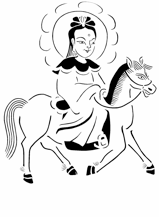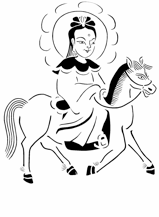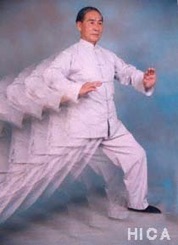Tagebuch
Diary





Tagebuch
Diary
The Pedigree of the House of Guo
December. 2001
In February of the past year a beautiful and graceful woman came to me. Carefully she took a bundle wrapped in velvet from her suitcase and opened it – 12 old Chinese picture scrolls! When we hang the pictures up, we had a magnificent panoramic picture in front of our eyes.
The pictures consist of paper, lined with a blue-green silk bordering and they are of classical beauty. Each hanging scroll is 175 cm high and 51 cm wide. The 12 pictures reach a total width of 612 cm. On the 1st and on the 12th picture there are 50 variants of the character »longevity«. On the picture in total an impressive hall together with a garden is depicted.
On each side of the building two red flagpoles are towering, on each of which a flag is affixed. The large characters on the flags mean »general«. Additionally, at both sides of the hall, pavilions are depicted. Many civilian and military officials of high rank are in the garden. In the interior of the hall six red lanterns, on which the words »residence Guo in Fen-Yang« is written in Chinese characters, are hanging. We mount the stairs in the picture and find ourselves now in the front hall ahead of a red carpet. On the left and on the right nine generals and high civil officials are standing in a reverential manner, all in the robe and headgear of the court. In the middle of the hall is a red table, on which a small platelet can be seen. On the chair left of the table an old man with a white beard is sitting, dressed in the red dragon robe. At the right, there is a lady distinguished by a golden cap and a red Phoenix dress.
Through investigation of the paper it can be determined, that the picture originates from the end of the Ming dynasty. The room, in which the picture had been hung up, must have been at least 10 m wide. During the latest mounting of the picture (around 180 years ago, as the silk reveals) the damaged parts had been cut away. In order to facilitate the storage the picture had been divided into 12 smaller picture-parts.
After repeated investigation of the artwork I dare to conclude, that the picture shows the famous minister of defense of Tang dynasty – General Guo Zi-Yi – a man, who had accomplished all of the four Chinese categories »prosperity, career, a long life and great accomplishments« during his lifetime (697-781). The emperor Xiao-Zong endowed him with the title »King of Fenyang«. Our picture served the descendants of the House of Guo during ancestor sacrifices.
But how has this valuable artifact of the Guo family come to Germany?
From 1898 to 1914 Germany occupied the Jiaozhou bay in Shan-Dong province. Maybe the artwork was brought to Europe by a German missionary, a merchant or a soldier during the turmoil of war. To restore an old picture means at same time to study its history and to feel an artwork created by a master craftsman. Politics and economy are changing constantly, only culture is everlasting.
The restoration
The condition of the picture before the restoration was documented. Then I started with preparatory works – I selected suitable paper and silk, both likewise dyed according to the original hues.
After these preparations I started with the actual restoration process: washing cleaning, neutralizing…
The construction of the mounting of a Chinese picture comprises several layers. The actual painted original represents the uppermost layer. This is glued from the back with a paper layer, which is called »life paper« or »heart« in Chinese. The life paper again is lined with two further layers of paper, the last of which represents the back cover of the entire picture. For the restoration the original has to be detached from the added paper layers. Then damages on the original are fixed. Afterwards a new life paper and the two additional layers of paper are put on anew.
The repeated restoration at regular intervals and the new lining of Chinese scroll pictures is necessary because the whole system of the artwork concerned is a compound system, which is kept together through the means of organic adhesives. These are degrading in the course of time and the adhesive has to be renewed about every 100 years.
Using a scalpel, pincers and the finger I carefully detached the papers at the back of the picture, layer after layer. During this process I realized that the picture had already been restored some time before, as missing parts had been amended on the original from the back. Afterwards tears were mended and missing parts of the original were complemented. After more than 20 operational steps, restoration- and mounting-work, the pictures, one after the other, shone in new splendour,
When I gave the pictures back to their owner, the beautiful lady beamed happily and said: »Please don’t forget to tell me another story of the Guo family.«
Additional note
During a visit in Taiwan in 2001 I happened to meet a descendant in the 75th generation of General Guo Zi-Yi, a 90-year-old Qigong-Master, Mr. Guo Xiao-Wu.
I told Mr. Guo of the restoration and I showed him the photograph of the picture. He was very moved and he asked me: »In my home country such a picture was hung up during the ancestor sacrifice in the ancestral temple on the birthday of General Guo and on important festive days. During the Cultural Revolution all these cultural artifacts were destroyed. Even our family register was burned. I have been looking for these pictures for 50 years. The picture you restored certainly originates from our family.«
General Guo Zi-Yi
The renowned general of the Tang dynasty, Guo from Huazhou. In his lifetime he witnessed and served four emperors: Xuan-Zong, Xiao-Zong, Daizong and De-Zong. During the reign of Emperor Xuan-Zong the rebellion broke out: An Lushan launched a military campaign against Yang Guo-Zong (the brother of the Emperor’s concubine Yang Guifei) and overthrew the capital Lo-Yang. The Emperor took flight. On the road, in Maweipo, Yang Guo-Zhong and Yang Guifen fell into the hands of several generals and they were killed. This is known in history as the »An-Loshang Mutiny«. During the reign of Emperor Xiao-Zong Guo was appointed minister of state defense. During his life time he was upgraded many times and also deprived again of his office many times due to envy and defamation at the Emperor’s court. But whenever the country was in danger, the Emperor remembered him.
And then he fought again for his home country without ever complaining. He is praised in history books as the one, who »serves the emperors loyally, who tolerates his subjects and who treats his fellow men with respect.«
An eunuch named Yu Chao’en envied Guo and tried repeatedly to intrigue against him. One time, when Guo went on the field, Yu Chao’en had the family tomb robbed. Gou returned and took revenge. In tears he said: »In the war I couldn’t keep my soldiers from disgracing the graves of others. Now the tomb of my father has been looted and I should not punish the offender.«
Another famous anecdote is the rescue of the poet Li Bai (the Chinese Goethe) by Guo. Once Li Bai had insulted the eunuch Gao Li-Shi in front of the Emperor Xan-Zong: While drunk he made Gao take off his boots. Since that Gao bore tremendous hatred for Li Bai. He denounced Li Bai for having insulted the Emperor’s concubine Yang Gui-Fei in one of his poems. As a consequence, Li was banished and he sought the support of King Li Lin. But when Li Lin’s revolt against the Emperor was defeated, Li Bai had to go into prison. It was Guo, who stood bail for Li Bai and who saved him from captivity. This incident was later recorded by Li Bai in a poem and the friendship on the part of Guo was praised.
Moreover, there is a stage play about the Guo family. The third son, Guo Ai, was married to the Princess Sheng-Sing. One day the couple had an argument. Guo got angry: »You are taking your imperial father as a protector. But my father is able to ignore the Emperor.« Thus annoyed the princess returned to her parents’ home. If the Emperor got angry about that, this might drag the whole House of Guo into a disaster. Guo Ai was brought in fetters before the emperor by his father. The Emperor Daizong smiled: »The discussion was one between the married couple. We don’t have to take it seriously. Surely you now the saying: -Neither deaf nor dumb you can not be a good father-in-law-?« The Emperor sent his daughter back and Guo Ai was given a sound thrashing at home.
HICA
